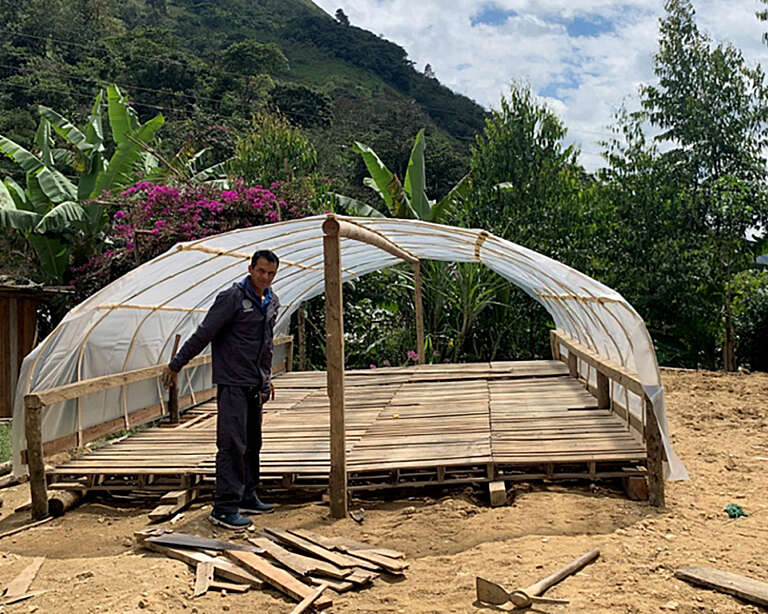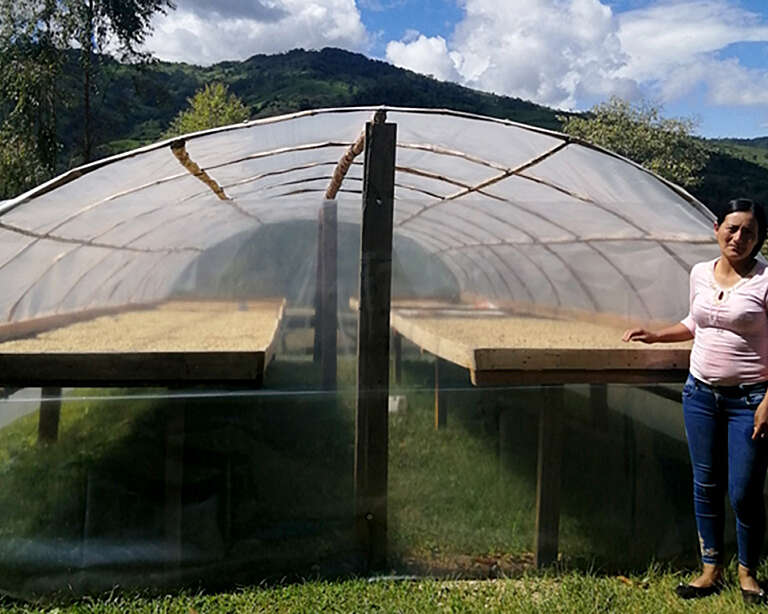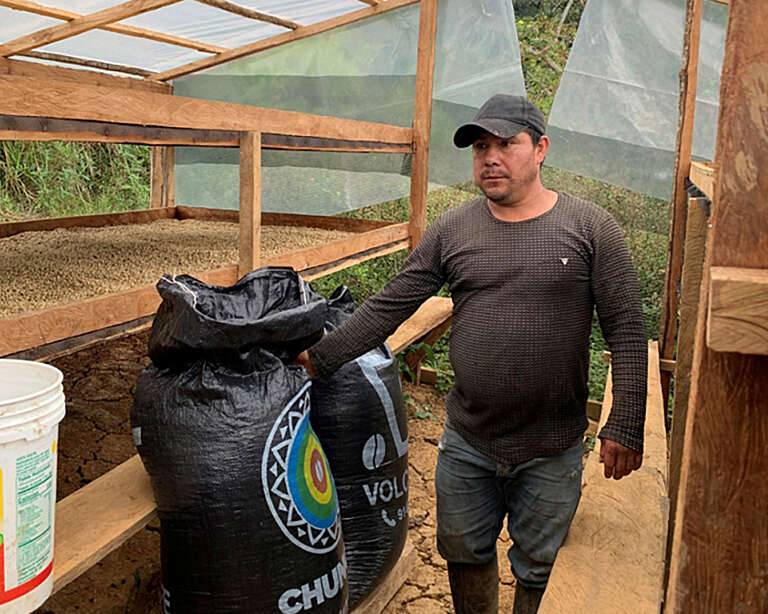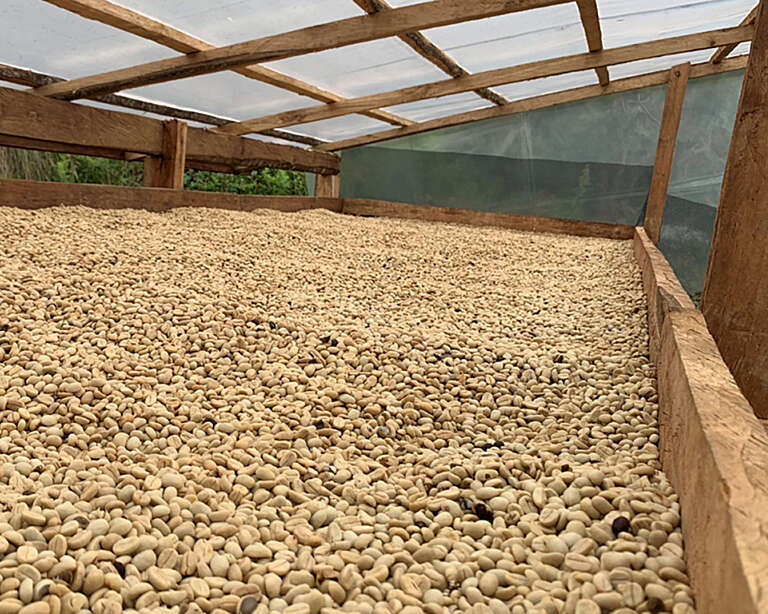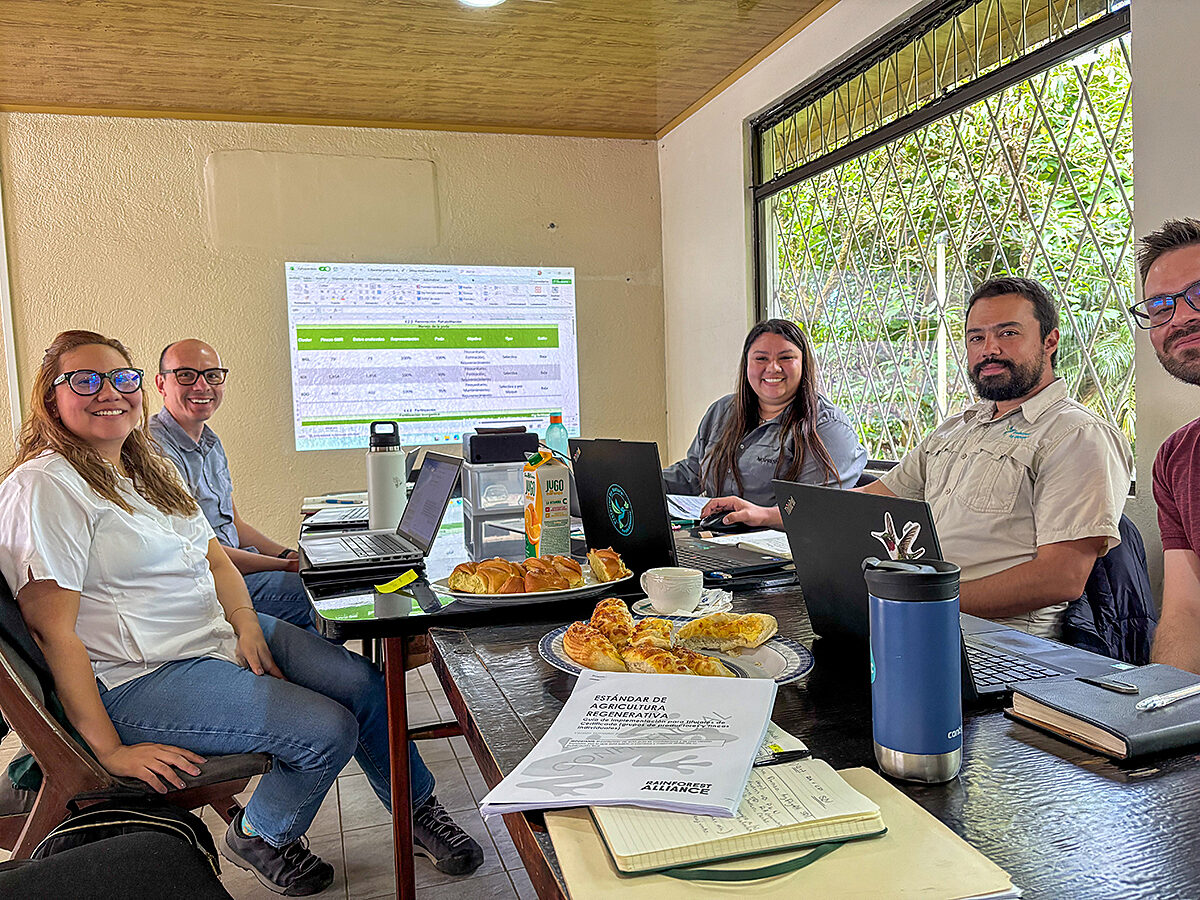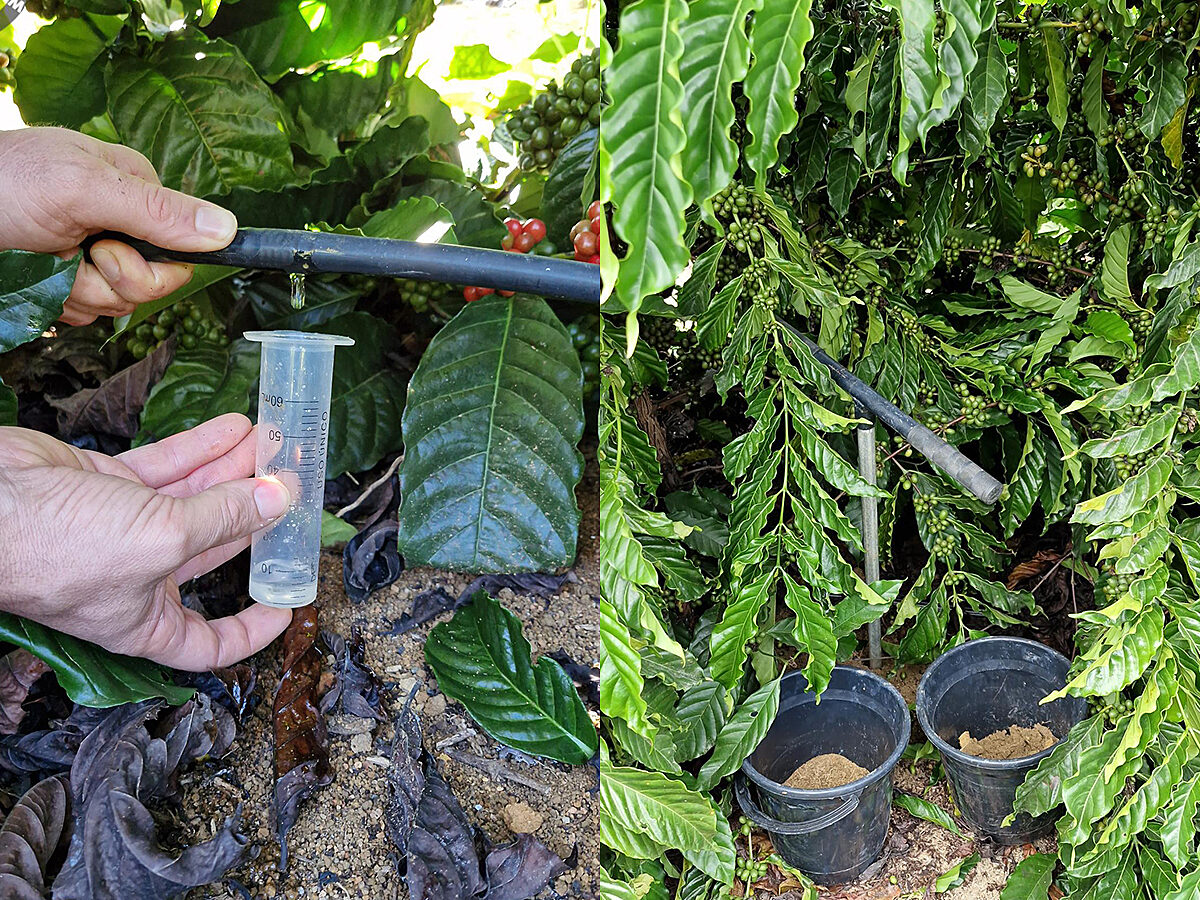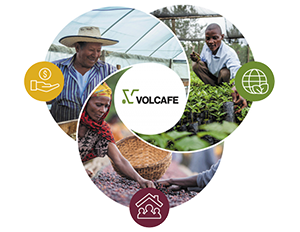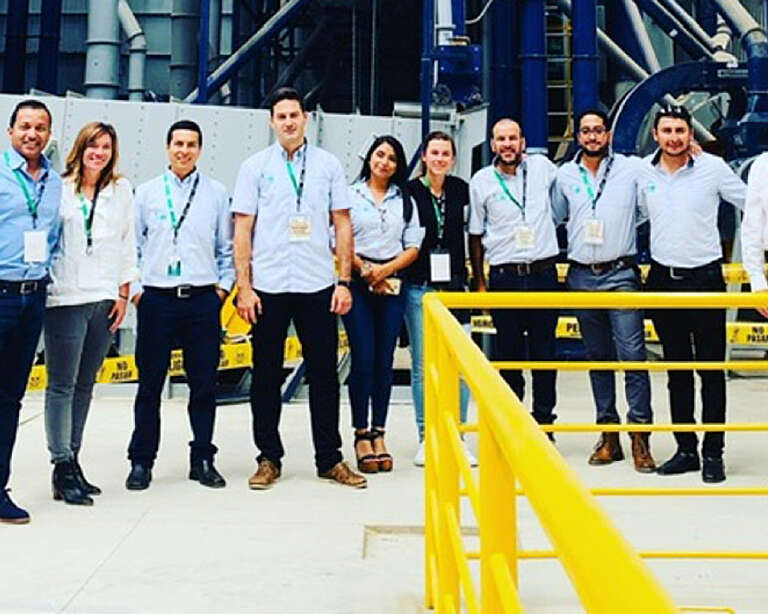The right tool for the job
Solar dryers in Peru
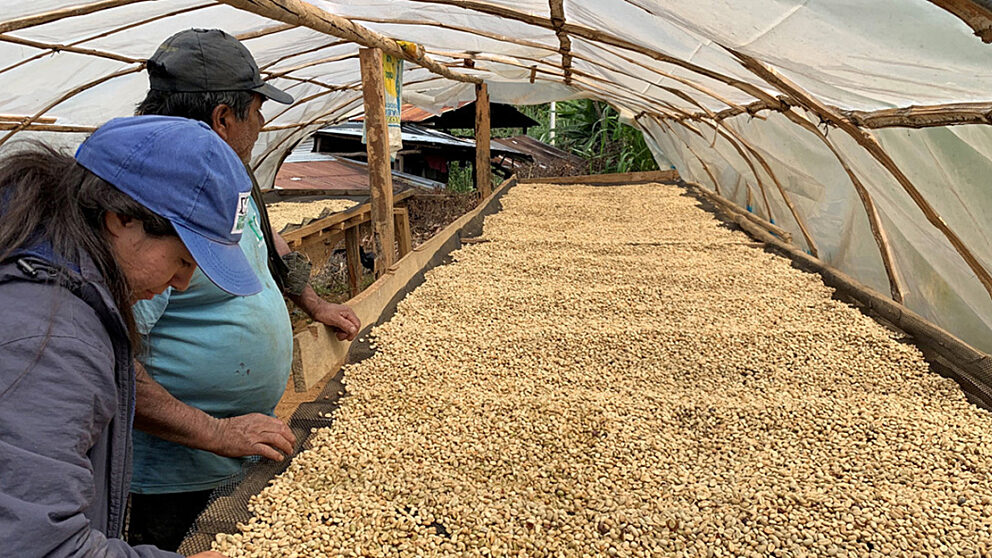
Farmers inspect the drying coffee beans.
Simple structures solve a dilemma that often costs farmers money and time
Despite the intense flavours coffee can produce, it starts out as a somewhat delicate plant that requires the careful attention of farmers to ensure a bountiful harvest. Once the ripe red coffee cherries are picked, they need to be processed and dried. Traditionally, coffee has been dried in the open air – requiring a large, unshaded area where the beans can be laid out on tarps, patios or single-tier racks to dry in the sunlight and fresh air.
While open-air drying is widely used and can yield great coffees, there are some drawbacks to the approach depending on the local conditions. For instance, as the beans sit exposed, it’s possible that humidity, inclement weather, animals, and insects can damage them. And if the outdoor conditions aren’t dry enough to extract moisture, the beans can start to ferment, which can lead to undesirable effects on the coffee’s taste.
In some locations, finding the space to dry in the open air is challenging: a wide tract of relatively flat land is needed, which can be rare in mountainous areas and may preclude other uses for such land. Open-air drying can also take time away from farmers who have to continually monitor the process – depending on a number of factors including air temperature and the degree to which the beans have been washed, it can take anywhere from six days to nearly three weeks for beans to dry in the open air. That can add up to a lot of in-person checks by a farmer.
In some coffee regions, open-air drying is cost-effective and these potential problems can be controlled – but in some areas, new techniques are helping to offset the aforementioned challenges.
It is important that coffee farmers can sell their coffees with the right humidity and maintain good properties. Solar dryers help ... deliver the best quality to our clients.
Our Volcafe Way farmer support teams regularly engage with coffee farmers to share technical advice and guidance on good agricultural practices. In the course of their work, our Peru field teams noticed that open-air drying was becoming a challenge for coffee producers in several of the regions they support – farmers were seeing their beans degrade during drying, leading to lower quality and a lower price for their produce.
“The traditional drying process in Peru is solar drying on plastic blankets or in a home’s attic. This type of drying is cheaper than buying covered solar dryers, but it has the drawback that farmers must be aware of climate changes,” explains Pilar Barquero, trader with our Peru team.
“If it rains the coffee is collected immediately, otherwise the coffee can recover its moisture and defects such as mould, fermentation or phenol may be present. Substances emitted by the ground can also affect the coffee and present defects. In addition, the coffee does not dry uniformly,” notes Barquero. “Each defect will mean a discount in the final price.”
To address these concerns, our Peru team turned to a simple yet effective technology: solar dryers.
To the untrained eye, a solar dryer looks like a greenhouse made of glass or plastic sheeting supported by a wood frame. The transparent covering means solar radiation heats the air inside, while shielding the contents from the elements. Interior conditions can be regulated by controlling the ventilation or blocking some of the sunlight. Racks of beans can be stacked inside the solar dryer, where the special ‘climate’ created means direct exposure to the sunshine isn’t necessary to allow drying.
During the past two years, Volcafe Peru has built 812 solar dryers in three key coffee-growing areas of the country’s northwest: Moyobamba, Jaen, and San Ignacio. Funding for the dryers comes partially from Volcafe customers, with the dryer installations serving as a positive incentive for farmers to improve coffee quality in conjunction with Volcafe Way field staff. Well-performing farmers are rewarded with the installation of a personal solar dryer at their farm.
To date, 435 solar dryers capable of processing 8 quintals (46kg) each have been installed, while 377 are larger dryers that can handle double the capacity. The solar dryers reduce the typical drying time to as little as eight days in areas where it once took up to 20, which helps minimise losses and removes a potential bottleneck from hundreds of farmers’ production cycles. During the roughly four months of the harvest period, a typical solar dryer can dry an impressive half tonne of coffee beans.
“Coffee drying is the last and one of the most important processes to obtain a product with commercial characteristics that allow it to enter the competitive market and fetch good prices,” says Barquero. “For Volcafe it is important that coffee farmers can sell their coffees with the right humidity and maintain good properties. Solar dryers help the coffee to be stored in good conditions and deliver the best quality to our clients.”
Alongside open-air approaches and solar dryers, there are various mechanical approaches to drying as well. Given the range of coffee lands and harvest conditions, each of these techniques can play a role in enabling sustainable profitability for coffee farmers. Through our Volcafe Way farmer support programme and sustainability projects, Volcafe’s on-the-ground teams seek to identify challenges that farmers face and assist with providing solutions – whether that’s building solar dryers in Peru or Honduras, finding new ways to promote regenerative agriculture in Costa Rica or Uganda, or running projects to safeguard nature in coffee regions in Colombia or Vietnam.
Quick facts
Country: Peru
Objectives: Build solar dryers to support coffee farmers in ensuring stable quality and heightened value for their produce
Timeline: 2021 onwards
Impact: Total of 812 solar dryers constructed, with 435 small and 377 large units for a total of 9512 quintals of drying capacity per harvest season (3-4 months). Each solar dryer serves one farming household.
Marie Renou-Ullrich, Head of Marketing and Communications, email hidden; JavaScript is required


